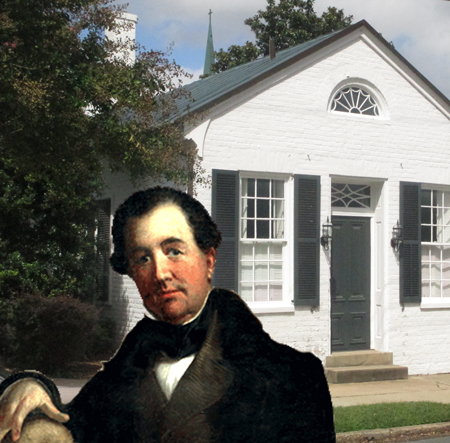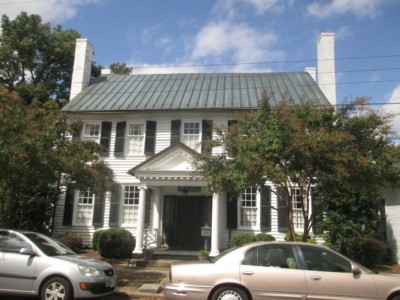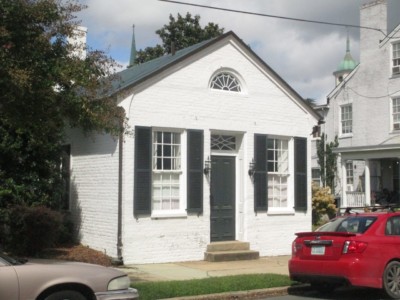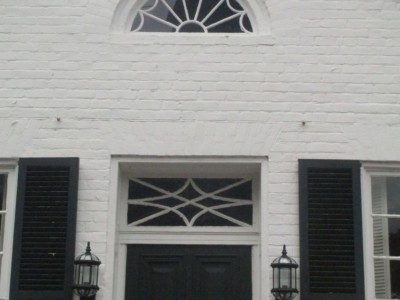The Carmichaels gave us three Vestry members over two centuries plus a fourth member of that family who served the church. All four were local doctors. The name and first Vestry are provided for those who served the Vestry:
1. Dr. James Carmichael, 1810
Carmichael was originally from Glasgow Scotland. Carmichael’s uncle Dr. George French played a key role in his medical career. French sent him to Edinbaugh for medical studies. Since French was serving his first term as mayor of Fredericksburg in 1790 (he was to serve eight!) he certainly would have recommended Fredericksburg for a medical career. He came here in 1791. In June 1794 Carmichael married Elizabeth Hackley and together they had six children. Two of the boys joined their father in his medical practice. In advertisements placed in the local newspapers, Edward was announced as joining his father’s practice in May 1817 and George joined eleven years later in May 1828.
In 1816, Dr.James Carmichael, from Glasgow, Scotland, bought 309 Hanover, from Charles Yates, a prominent Fredericksburg merchant who had built it in the 1780’s. There are eight rooms in the house, four on each floor, attic and basement. There is an entrance from the house into the office, which is an antique, brick building, stone steps, stationary blinds, or shutters.
In 1820, Dr. Carmichael built the small brick office, 307, for his “medicine shop.” Five Carmichael doctors in four generations treated Fredericksburg residents here. Four Carmichael doctors have practiced their profession in this office – Dr. James Carmichael, then his son George, grandson Spotswood, great grandson Randolph Carmichael.
The daybook, a record of credits and debits to their medical practice between 1816 and 1817, is the only document composed by the James and his sond Edward Carmichaels. The unique feature of the collection is that the letters, dated 1819 through 1830, are written primarily by patients or their family members. Typically, an ill individual, or someone writing on his or her behalf, scrawled a note describing a complaint, requesting medicine, or appealing for a visit from the doctor. Since the Carmichaels functioned as pharmacists as well as doctors the patients recommended various cures. 100 families from this area are contained within the letters Worms, malaria, dropsy, dysentery, venereal disease, rheumatism, and bowel complaints are a few of the more frequent ailments plaguing their clients. Other doctors used Carmichael’s knowledge and experience for their cases.
The University of Virginia purchased the daybook in 1998 and built a website around it. As they write “The Papers of James Carmichael and Son provide a captivating look into the lives of the early nineteenth-century inhabitants of Fredericksburg, Virginia, and its surrounding rural areas.”
Apparently, Carmichael had quite a sense of humor. Mr. R. R. Howison relates the following incident about
him which was taken from the University of Virginia website:
“Mr. Howison’s mother was very ill for some time, and
Dr. Carmichael constantly attended her. One morning the
family thought she was better. The doctor came in as usual,
and went to her bedside, looked on her face, looked into
her eyes, took her wrist in his fingers and felt her pulse.
A look of relief passed over his features, and these were
the exact words he uttered: “Well, I am glad to tell you
that the devil will not get you this time”. She knew his
ways very well, and answered him: “Doctor, you ought not
to talk so. I hope that if it had pleased God to take me
away from this world, he would have saved me from the
Evil power you speak of”. He shook his head, but a smile
beamed over his face, as he answered: “I don’t know about
that. Not so certain, Satan is very busy with all of us.”
“The doctor was eccentric, but skillful, had a large prac-
tice, and was very successful. As a rule he never indulged
in liquor of any kind, but at long intervals, often more
than six months apart, he got into what was called a “spree”.
When he was indulging in this manner he would spend several
days, sometimes a week, in doing the most eccentric things.
He would stop at the houses of some of the families, where
he practiced, and after knocking, if there was no response,
he would break out the lower panels of the front door and
creep in. While the old doctor was indulging in these
sprees, his patients were carefully attended by other physi-
cians of the town. He would never make a professional call
while he was in the slightest degree under the influence
of liquor.”
Earlier James Carmichael served from 1810-13 on the Vestry. As was the tradition at the time the Vestry was elected on Easter Monday and included– Robert Wellford, John Smith, Jr, Zachariah Lewis, Dabney Herndon, Robert Patton, William S. Stone, William Bernard, George Spooner and James Carmichael. The term was dominated by a changed of ministers from Rev. Sam Low in 1810, to George Strebek in Oct. 1811 and a delayed response to making needed repairs on the church
The Vestry resolved to raise money to do this in April, 1810 and appointed James Smock and Zachariah Lewis but no action. In 1811 a year later these Vestrymen were urged “wait on the inhabitants obtain a certificate for repairing the church and enclosures around the burying ground are requested to carry said order into effect soon as possible.
In Nov. 1811, a new committee of Carmichael, H. Marshall, Dabney Herndon and William S. Stone were appointed to get subscriptions to the church. The Wardens would also place boxes at the church door to received donations for the building.
In April 1812, a Committee under Hugh Mercer, Zachariah Lewis, John Smith, William S. Stone and Dabney Herndon was appointed to raise funds by subscription or otherwise for the repair of the church and return an accounting back to the trustees on or before May.
Thus it took from April 1810 to 1812 to appoint a second committee and to give them a deadline of reporting back.
Finally, on June 12, 1812 , this second committee reported that the inhabitants want to build a new church. New subscription would be organized for this purpose under Hugh Mercer , William Bernard, William Stone, Benjamin Day for a building a church of brick or stone. Minister were urged to help and wardens provide necessary documents for that purpose.
Carmichael ended his service by Easter Monday 1813 On July 13, 1816 James Carmichael purchased pew that Benjamin Parke did not pay for. Beyond this there are no records as the Vestry Minutes from 1817-1865 were mostly probably lost or destroyed in the Civil War
2. E. H. Carmichael (probably Dr. Edward H. Carmichael), 1834. We don’t have records of that service.
Edward formed a practice reported in the Virginia Herald in May , 1810, Carmichael Browne and Company. He and many Carmichaels practiced in the House that James Carmichael built in 1822. At his death April, 1854, the Weekly Advertiser wrote that he was an “eminent practitioner of medicine and surgery.” In between that time he was very active as a committee person 1831-1833 in creating a Mary Washington memorial
By the late 1830’s he moved into iron a natural investment for the developing railroads. An increasing economic activity followed President Jackson’s attack on the National Bank and a protective tariff on iron aided investment.
Dr. Edward H. Carmichael along with fellow investors Francis Deane, John Heth, John S. Wellford, and Alexander Henderson were the original incorporators in the Fredericksburg Iron and Steel Manufacturing Company. A twenty-year charter authorized the company to manufacture “iron, steel, and materials of the like nature” and the ownership of up to 5,000 acres of land to help with this process in in Spotsylvania, Stafford, Orange, Louisa, Culpepper, Rappahannock, and Fauquier counties. Deane and Heth has involved in mining. Carmichael and Wellford were investors and had worked together. Wellford’s led the firm with connections in Fredericksburg and existing successful investments and established the Catharine Furnace near Chancellorsville.
Carmichael had sales abilities and helped sell Catharine Furnace’s initial production to the Tredegar Iron Company in Richmond
3. Coalter B. Carmichael, 1937
He served from 1937 to March 1946 when he withdrew his name. This was when rotation of the Vestry began, though it had been considered earlier in 1939 but not acted upon.
During his time the church had to deal with the death of a rector (Dudley Boogher) and short term of the next record (J. Sullivan Bond). The existing rectory on Hanover Street was sold and the last of the stained glass windows were installed (Nativity). A new heating system was installed after discussions lasting over 1939 and 1940. There was discussion of the intinction method of distributing communion which was approved by the rector.
He frequently served on the committee to audit the treasurer’s books as well as the Memorial Committee. He did not serve on the larger committees– property, music or finance.
He did serve on temporary committees, notably one into church attendance. with C. Archer Smith, George L. Hunter, W. W Braxton, and Charles Lewis. A specific problem of attendance not mentioned. There was moderate growth in the 1930’s. From 1930-1946, the number of communicants rose from 278 to 371 or 33%. A more vibrant music program and Elsie Lewis’ leadership in the Sunday school may have caused some of the growth. Also the country was in depression which may have accelerated church going.
That did not necessarily translate into more revenues. In 1937, the minutes the mention a falling of revenues due to death of a large number of member. Treasurer George Hunter reported a deficit of ($550) existed in relationship to Parish Quota to diocese (Parish Pledge). In 1940, the Vestry recommended a special collection at Pentecost to relieve the deficit in the church budget. In 1940, he recommended a “gift box” be placed in the church for donations. In 1941, discussion about re-uniting Trinity and St. George’s ensued but was stalled.
War issues intervened infrequently during Coalter’s service. A recreation room for soldiers came before the Vestry in 1941. Vestry designed the “Sunday School Room” (Faulkner Hall) for that purpose approving the first electric light to be placed outside. In 1942, Vestry approved 36 Prayer books to be purchased for distribution to soldiers. In the same year the “basement of the church” (Sydnor Hall) may have been used for Red Cross purposes though the decision up to the rector. The minutes note the oil shortage.
The threat of war caused the Vestry to purchase $20,000 of War Risk Insurance. One member of the Vestry Walter Chinn, Jr. resigned to join the military. By 1945, there were would be offerings the Army and Navy Commissions.
4. Oral History with Dr. Elizabeth Carmichael
During the 1940’s, the Women’s Auxiliary, the predecessor of the ECW sponsoted a girl scout troop. Elizabeth Carmichael was the troop leader at the time.
Oral History Project
Historic Fredericksburg Foundation
2001-2002
Elizabeth Carmichael was the last doctor in the family and daughter of Coalter Carmichael.
Interviewer: You mentioned your mother was Presbyterian. Anything else, church wise, to mention?
Dr. Carmichael: She was big in the circle meetings and very active in church affairs. If she had been active now, she would have been a deacon or elder when women could be. My father was over at St. George’s. He was a vestryman.
Interviewer: They did go to different churches?
Dr. Carmichael: Oh, yes. They went to different churches and I bounced between the two churches. I went to the Presbyterian Sunday School -hated it! I went there because my mother said, “You’ll learn more from the Presbyterians. The Episcopalians don’t teach anything in their Sunday School. They’re terrible and you’re going to the Presbyterian Sunday School. “Well, I didn’t care for the minister in the Presbyterian Church. He was too folksy for my taste. I liked Mr. Boogher over at the Episcopal Church and I sang in the Episcopal Children’s Choir. I went back and forth; I would go with my father, then with my mother. Finally my mother said, “You’ll have to come with me for a year to church. You have to come to the Presbyterian Church for a year, and at the end of the year, if you still want to be confirmed, all right. The year went by and I said, “I want to be confirmed! Because with some of Mother’s friends, it was as if I was going to join the Rev. Moon’s outfit. The fact that I was going to give up the Presbyterian Church, was sacrosanct in her view, athough, her father had been an Episcopalian and her brother had been an Episcopalian. But she was extremely adamant that I was going to be Presbyterian. And I couldn’t stand the Presbyterian Church, I’m perfectly frank about that. Even now, it sets my teeth on edge to go there. And I shouldn’t have the tape on right now, but it does. There’s an informality about it that I don’t like. And there’s also an informality now in the Episcopal Church which I don’t care for. I find it distressing so much. That is why I now go to the Anglican Church. There is one in Fredericksburg called St. Luke’s. It is out on Mr. Melcher’s land, up that steep hill on Route 17 on the left. We have one in Warrenton. The main thing is the 1928 prayer book. They threw over the old prayer book. And got into this “well hallowed be your name” and “passing the peace” and all that. It’s not what I want in my church, I don’t prefer it. I think religion is very personal and the way you practice your religion is an extremely personal thing. Whether or not you go to church is a very personal matter. It’s just doesn’t do anything for me. After I was going to church, they instituted the new prayer books and they dumbed down the hymnal – you can’t say “man” in the hymnal now—they’ve got a “person” or something that doesn’t fit the tune. To me, it’s a travesty. From my point of view it’s a total travesty. I’m not comfortable with it. I still put flowers in the Presbyterian Church for my mother. I don’t in the Episcopal Church for my father. I put them in for my parents, for both of them. Well, my father’s father was a Presbyterian; he was brought up a Presbyterian. They’ve been side by side, one way or the other for generations, for hundreds of years. But some of my mother friends, “What! You’re letting her do this”? Anyway, that’s my religious situation, I guess.
This last conversation took place over the phone with Dr. Carmichael on January 3,2003.
Dr. Carmichael: I attended the Junior Choir at St. George’s; all my friends belonged. You did not have to go to that church to belong to the Choir. Elsie Lewis was the person who ran it and Dudley Bougher was the rector. For many years, we sang for the Lent and Easter services which were very well attended. It was a way to keep us off the streets. Even though you could be on the streets of Fredericksburg when I grew up. Fredericksburg was a wonderful place to grow up. We could walk to school. We didn’t have so many activities as they do now. Now, you have to take everyone to practice all the time and everyone is so hurried. Youth is wasted on the young.
Interviewer: Dr. Carmichael and I are happy that it is raining and that the water level is up again. She is taking a trip to England soon. Thank you for letting us come into your home and interview you. It has been most enjoyable to talk with you, Dr. Carmichael.





